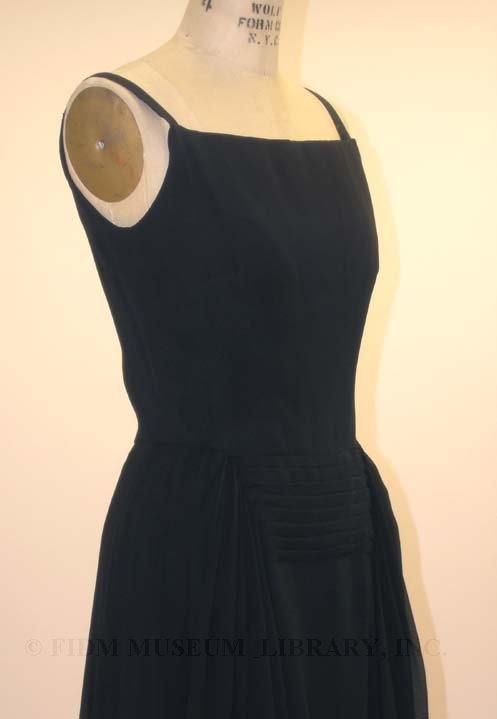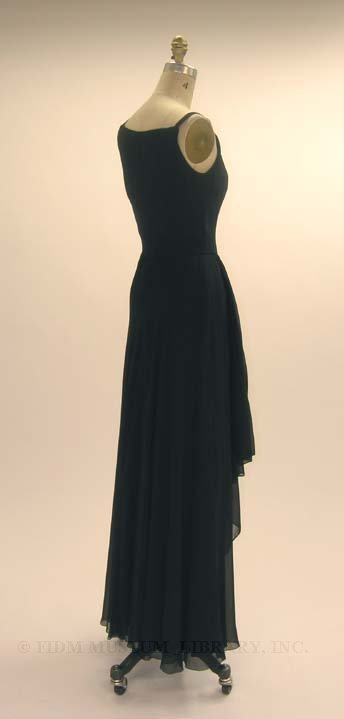Mainbocher
Based on his experience as a Paris-based illustrator for Harper's Bazaar and editor of French Vogue, Chicago-born Main Rousseau Bocher (b. 1890) decided that he was entirely capable of opening his own couture house. He did so in 1930, first contracting his name to Mainbocher. Within 4 days, Mainbocher began to receive orders. Though Mainbocher was known to the fashion establishment due to his work as an illustrator and editor, opening a new couture house with minimal technical experience was a bold move. Years of apprenticeship and skill-building with an established couturier were the more usual path to success. Relative inexperience coupled with the start of what became a decade-long depression might have discouraged a less confident and focused individual. Despite these apparently unfavorable circumstances, Mainbocher went on to have an extremely successful career based on his ability to "dress women like ladies."1
At the start of World War II in 1940, Mainbocher closed his Paris salon and moved to New York. Though he intended to stay only for the duration of the war, he worked in New York until his retirement in 1971. In New York, as in Paris, Mainbocher's clientele (always referred to as friends) were drawn from the most elite echelons of society. Gloria Vanderbilt, Diana Vreeland, C.Z. Guest and Babe Paley were among his New York clients. Due to a policy of accepting new clients only through personal recommendation, Mainbocher's salon was known as the most exclusive in New York City. Further reinforcing the impression of exclusivity was the lack of advertising. Rather than placing ads in fashion periodicals, Mainbocher relied on word-of-mouth publicity.
Mainbocher's garments were created in the strict tradition of haute couture. Clients selected a garment or garments based on the models seen during the daily 3 p.m. showing at the salon. A personalized garment was then created specifically for the client and fitted over several weeks. Due to their high-quality fit, construction and fabric, Mainbocher's garments were extraordinarily expensive and long-lasting. A 1961 Vogue feature on Mainbocher noted this, suggesting that anyone interested in Mainbocher's work carefully weigh the "spectacular longevity of Mainbocher's clothes as a good, long-range-economy argument for paying prices among the highest in the world."2

Evening gown
Silk
Mainbocher
1956-58
Gift of Lillian Tucker
2006.858.1
Mainbocher's aesthetic changed little throughout his career. A 1959 New York Times article compared Mainbocher evening gowns from 1959 and 1940; except for a slight changed in neckline, the long, slim, silhouette was nearly identical. In discussing his remarkably consistent aesthetic, Mainbocher said, "our collections glide into one another."3 The floor-length gown pictured here is representative of Mainbocher's style, particularly the waist-level detail of pleated self-fabric panel. Mainbocher was interested in the waist, often using overskirts, belts, removable fancy aprons, swags or tucks of fabric to emphasis this area of the body. In fact, Mainbocher is often credited with a 1939, pre-New Look promotion of a defined waist.
Though Mainbocher's aesthetic consistency earned him a devoted clientele, it became increasingly anachronistic during the 1960s. During this decade the fashion world witnessed dramatic changes, with high-end ready-to-wear largely eclipsing couture. As Mainbocher had no interest in designing for this market, he was pushed to the sidelines in an increasingly commercialized fashion world. In the midst of these changes, a Mainbocher employee embezzled a large sum of money in 1964. This financial disaster and the threat of a large rent increase prompted Mainbocher to close his salon and retire to Paris in 1971.
1 Flanner, Janet. "Profiles: Pioneer" New Yorker 13 Jan 1940: 24.
2 "The Man behind the Mainbocher Look" Vogue June 1961: 118.
3 Ibid.

